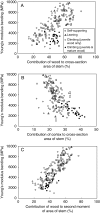Developmental plasticity and biomechanics of treelets and lianas in Manihot aff. quinquepartita (Euphorbiaceae): a branch-angle climber of French Guiana
- PMID: 19351684
- PMCID: PMC2685309
- DOI: 10.1093/aob/mcp078
Developmental plasticity and biomechanics of treelets and lianas in Manihot aff. quinquepartita (Euphorbiaceae): a branch-angle climber of French Guiana
Abstract
Background and aims: Most tropical lianas have specialized organs of attachment such as twining stems, hooks or tendrils but some do not. Many climbers also have an early self-supporting phase of growth and in some species this can produce treelet-sized individuals. This study focuses on how a liana can climb without specialized attachment organs and how biomechanical properties of the stem are modulated between self-supporting treelets and canopy-climbing lianas.
Methods: Biomechanics and stem development were investigated in self-supporting to climbing individuals of Manihot aff. quinquepartita (Euphorbiaceae) from tropical rain forest at Saül, central French Guiana. Bending tests were carried out close to the site of growth. Mechanical properties, including Young's elastic modulus, were observed with reference to habit type and changes in stem anatomy during development.
Key results: This liana species can show a remarkably long phase of self-supporting growth as treelets with stiff, juvenile wood characterizing the branches and main stem. During the early phase of climbing, stiff but unstable stem segments are loosely held in a vertical position to host plants via petiole bases. The stiffest stems--those having the highest values of Young's modulus measured in bending--belonged to young, leaning and climbing stems. Only when climbing stems are securely anchored into the surrounding vegetation by a system of wide-angled branches, does the plant develop highly flexible stem properties. As in many specialized lianas, the change in stiffness is linked to the development of wood with numerous large vessels and thin-walled fibres.
Conclusions: Some angiosperms can develop highly effective climbing behaviour and specialized flexible stems without highly specialized organs of attachment. This is linked to a high degree of developmental plasticity in early stages of growth. Young individuals in either open or closed marginal forest conditions can grow as substantial treelets or as leaning/climbing plants, depending on the availability of host supports. The species of liana studied differs both in terms of development and biomechanics from many other lianas that climb via twining, tendrils or other specialized attachment organs.
Figures






Similar articles
-
Phenotypic correlates of the lianescent growth form: a review.Ann Bot. 2013 Dec;112(9):1667-81. doi: 10.1093/aob/mct236. Epub 2013 Oct 29. Ann Bot. 2013. PMID: 24169592 Free PMC article. Review.
-
Trellis-forming stems of a tropical liana Condylocarpon guianense (Apocynaceae): A plant-made safety net constructed by simple "start-stop" development.Front Plant Sci. 2022 Dec 19;13:1016195. doi: 10.3389/fpls.2022.1016195. eCollection 2022. Front Plant Sci. 2022. PMID: 36600917 Free PMC article.
-
Climbing strategies of Taiwan climbers.Bot Stud. 2023 Sep 22;64(1):26. doi: 10.1186/s40529-023-00399-4. Bot Stud. 2023. PMID: 37736799 Free PMC article.
-
The evolutionary fate of phenotypic plasticity and functional traits under domestication in manioc: changes in stem biomechanics and the appearance of stem brittleness.PLoS One. 2013 Sep 4;8(9):e74727. doi: 10.1371/journal.pone.0074727. eCollection 2013. PLoS One. 2013. PMID: 24023960 Free PMC article.
-
The molecular control of tendril development in angiosperms.New Phytol. 2018 May;218(3):944-958. doi: 10.1111/nph.15073. Epub 2018 Mar 9. New Phytol. 2018. PMID: 29520789 Review.
Cited by
-
Geometry, Allometry and Biomechanics of Fern Leaf Petioles: Their Significance for the Evolution of Functional and Ecological Diversity Within the Pteridaceae.Front Plant Sci. 2018 Mar 7;9:197. doi: 10.3389/fpls.2018.00197. eCollection 2018. Front Plant Sci. 2018. PMID: 29563920 Free PMC article.
-
Bouldering: an alternative strategy to long-vertical climbing in root-climbing hortensias.J R Soc Interface. 2014 Oct 6;11(99):20140611. doi: 10.1098/rsif.2014.0611. J R Soc Interface. 2014. PMID: 25079869 Free PMC article.
-
Phenotypic correlates of the lianescent growth form: a review.Ann Bot. 2013 Dec;112(9):1667-81. doi: 10.1093/aob/mct236. Epub 2013 Oct 29. Ann Bot. 2013. PMID: 24169592 Free PMC article. Review.
-
Towards a liana plant functional type for vegetation models.Ecol Modell. 2024 Dec;498:110901. doi: 10.1016/j.ecolmodel.2024.110901. Ecol Modell. 2024. PMID: 39619676 Free PMC article.
-
Biomechanics of climbing palms and how they climb.Plant Signal Behav. 2009 Sep;4(9):875-7. doi: 10.4161/psb.4.9.9426. Epub 2009 Sep 2. Plant Signal Behav. 2009. PMID: 19847117 Free PMC article.
References
-
- Bradshaw AD. Evolutionary significance of phenotypic plasticity in plants. Advances in Genetics. 1965;13:115–155.
-
- Caballé G. Liana structure, function and selection: a comparative study of xylem cylinders of tropical rainforest species in Africa and America. Botanical Journal of the Linnean Society. 1993;113:41–60.
-
- Caballé G. Le port autoportant des lianes tropicales: une synthèse des stratégies de croissance. Canadian Journal of Botany. 1998;76:1703–1716.
-
- Dewalt SJ, Schnitzer SA, Denslow JS. Density and diversity of lianas along a chronosequence in a central Panamanian lowland forest. Journal of Tropical Ecology. 2000;16:1–19.
-
- Ewart AJ. On contact irritability. Annales du Jardin Botanique de Buitzenzorg. 1898;15:187–242.
Publication types
MeSH terms
LinkOut - more resources
Full Text Sources
Research Materials

